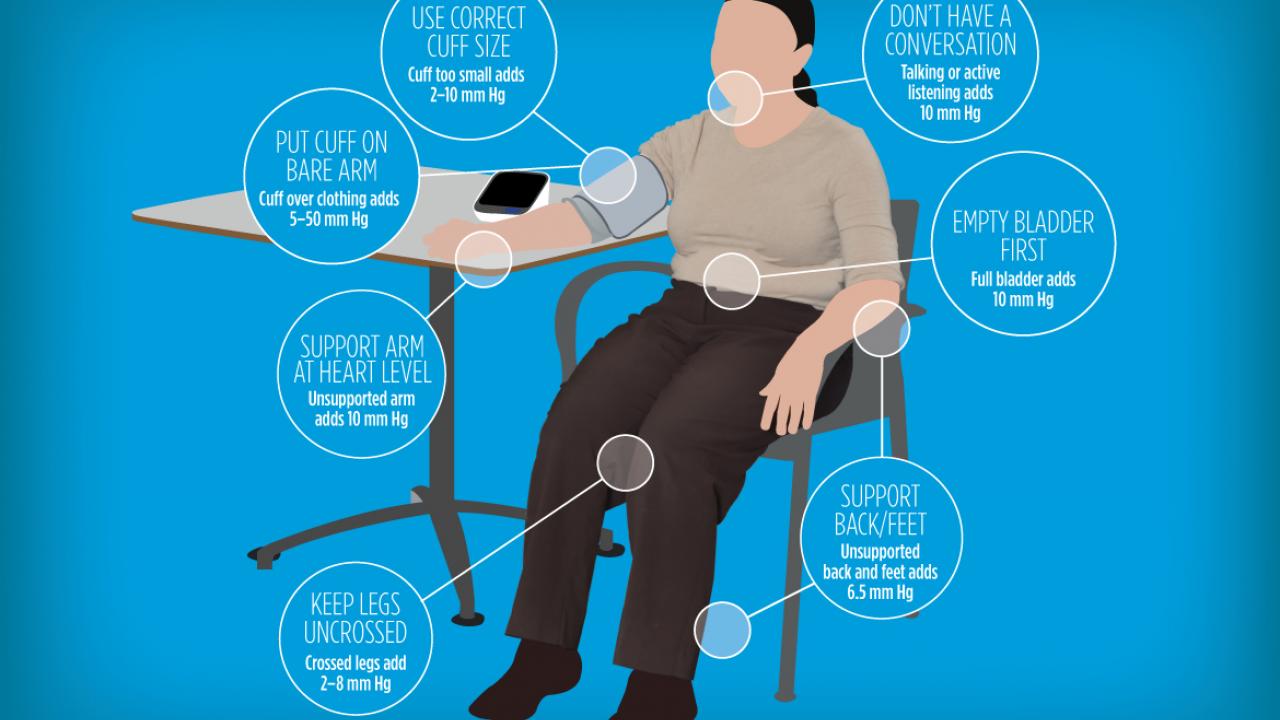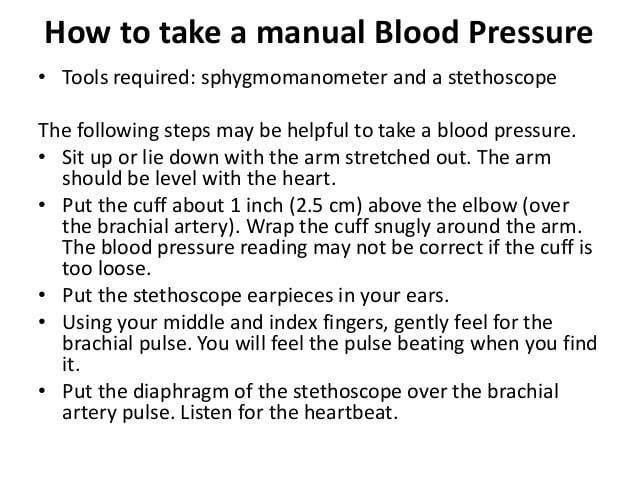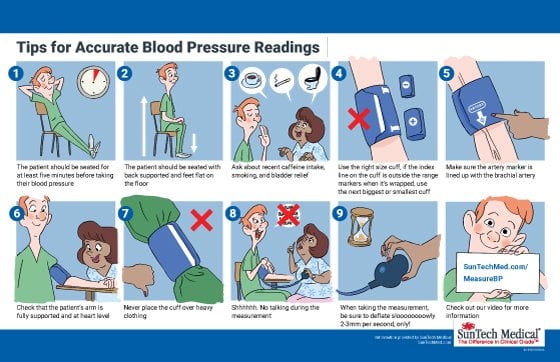How To Take Orthostatic Blood Pressure
Orthostatic hypotension is a medical term for the decrease in systolic and diastolic pressure withing three minutes of the pactient standing as compared with blood pressure taken while sitted. For taking orthistatic blood pressure using a cuff you will have to follow the steps ennuerated above, but also repeat the reading after standing 3 minutes. Dont forget about the pulse rate measurements too.
It is also important to:
- Take your blood pressure twice a day first in the morning, before breakfast but never right after you wake up and then in the evening. Compare the measurements to see how your blood pressure fluctuates after a day of work.
- Always record you readings and inform your doctor on the values you get. From time to time pay his or her a visit and check your measurements against theirs.
Learn that there are various ways to check your blood pressure at home. Now that you have discovered the essential steps concerning how to take blood pressure with cuff correctly, lets take a look at less popular or even unefficient ways to do it.
- How to take blood pressure with fingers
Unlike the popular belief that blood pressure can be determined by using your fingers, such measurement is totally inneffectual. On the other hand, you can use your fingers to check your pulse. Place your first and second fingertips on your arteries and as soon as you have felt your pulse begin counting the beats for 60 seconds.
- How to take blood pressure on leg
How To Use An Automated Blood Pressure Machine
The easiest way to take your own blood pressure is to purchase an automated cuff. Automatic blood pressure machines are the easiest to use, and theyre helpful if you have any hearing impairments.
These types of blood pressure cuffs have a digital monitor that will display your blood pressure reading on a screen. You can purchase these online, at most grocery stores, or at a health food store.
The American Heart Association recommends an automatic, upper arm blood pressure monitor for at-home use. To use your digital blood pressure monitor, follow the instructions that come with it. You can also take the monitor to your doctors office, or even your local pharmacy, for a demonstration.
You should also purchase a small notebook to start a blood pressure log. This can be helpful for your doctor. You can a free blood pressure log from the AHA.
Machines can give you a different reading than a manual blood pressure reading. Bring your cuff to your next doctors appointment so you can compare the reading from your cuff to the reading your doctor takes. This can help you calibrate your machine and identify levels you should look for on your own device.
Its also important to purchase a high-quality machine and monitor for errors. Even if you check your blood pressure at home, your doctor will still want to manually check it during appointments.
How To Interpret The Blood Pressure Reading
American College of Cardiology 2017 Updated Guidelines for High Blood Pressure:
- Normal BP- SBP: < 120 DBP: < 80 mm Hg
- Elevated BP- SBP: 120-129 DBP: < 80 mm Hg
- Hypertension Stage 1- SBP: 130-139 or DBP: 80-89 mm Hg
- Hypertension Stage 2- SBP: 140 or DBP: 90 mm Hg
For a patient to be diagnosed as having hypertension, they need an average reading based on 2 readings or more that are obtained on 2 or more occasions.
References
Don’t Miss: Does Spicy Food Cause High Blood Pressure
How Can I Measure My Blood Pressure At Home
Talk with your health care team about regularly measuring your blood pressure at home, also called self-measured blood pressure monitoring.
SMBP means you regularly use a personal blood pressure measurement device away from a doctors office or hospitalusually at home. These blood pressure monitors are easy and safe to use. A health care team member can show you how to use one if you need help.
Evidence shows that people with high blood pressure are more likely to lower their blood pressure if they use SMBP combined with support from their health care team than if they dont use SMBP.3
Use these additional tips for SMBP:4
- Use a blood pressure log pdf icon to record your blood pressure measurements.
- Take your blood pressure at the same time every day.
- Take at least two readings, 1 or 2 minutes apart.
Clinical Late Warning Signs Of Patient Deterioration

- Airway obstruction or stridor
- Respiratory Rate < 5 bpm or > 40bpm
- Pulse Rate < 40 or > 140
- Systolic BP < 80 or > 240 mmHg
- Excess blood loss not controlled by ward staff
- Unresponsive to verbal command or GCS < 8
- Urine output < 200mls in 24 hours or anuria
- ABG
- BE < -7
Some observation charts have an inbuilt tool, to alert staff of clinical changes that require medical intervention.
It is your responsibility to be familiar with your facilitys:
- Clinical Review System and
Read Also: Maxte Fitness And Activity Tracker Watch
How Do I Measure My Blood Pressure
Before you check your blood pressure, you should:
- Wait 30 minutes after eating or using caffeine, alcohol, or tobacco products.
- Go to the bathroom and empty your bladder.
- Rest for 3 to 5 minutes and do not talk.
- Sit in a comfortable position, with your legs and ankles uncrossed and your back supported.
- Elevate your left arm to the level of your heart. Place it on a table or desk and sit still.
- Wrap the cuff around the upper part of your bare arm. The cuff should be smooth and snug. There should be enough room for you to slip one fingertip under the cuff.
- Check the placement of the cuff. The bottom edge of it should be 1 inch above the crease of your elbow.
Below are the steps to take to use an aneroid monitor.
Below are the steps to take to use a digital monitor.
- Turn the power on to start the unit.
- On the automatic models, the cuff will inflate by itself with a push of a button. On the manual models, you have to inflate the cuff. You do this by squeezing the rubber bulb at a rapid rate.
- After the cuff inflates, the automatic device will slowly let air out.
- Look at the display screen to get your blood pressure reading. It will show your systolic and diastolic pressures. Write down the measurement in your record. The systolic pressure goes in front of the diastolic pressure. For example, 120/80.
- Press the exhaust button to release all of the air from the cuff.
- If you need to repeat the measurement, wait 2 to 3 minutes before starting.
Estimate An Approximate Systolic Blood Pressure
To begin with, you need to determine an approximate systolic blood pressure. This is helpful in preventing over-tightening of the cuff during the accurate measurement of blood pressure.
1. Ensure the valve on the blood pressure cuff is closed.
2. Palpate the patients radial pulse, located at the radial side of the wrist, with the tips of your index and middle fingers aligned longitudinally over the course of the artery.
3. Inflate the blood pressure cuff until you can no longer feel the patients radial pulse. Note the reading on the sphygmomanometer at the point at which the radial pulse becomes impalpable. This reading is an approximate estimate of the patients systolic blood pressure.
4. Open the valve and deflate the blood pressure cuff.
- Palpate the radial pulse
- Inflate the cuff until the radial pulse is no longer palpable
- Note the reading when the radial pulse is no longer palpable
Don’t Miss: Why High Blood Pressure Happens
What Does My Blood Pressure Reading Mean
Normal blood pressure is 120/80 or lower. High blood pressure is 140/90 or higher. If your blood pressure is between 120/80 and 140/90, you may have something called prehypertension. This means that you are at risk for high blood pressure.
| Systolic pressure | ||
| High blood pressure: Stage 2 | 160 or higher | 100 or over |
*If you have diabetes or kidney disease, high blood pressure ranges may be lower than for other people. Or, if you are older than 65, goal blood pressure may be higher. Talk to your doctor about what is considered high blood pressure for you.
How Do You Take A Manual Blood Pressure Reading Accurately
To check the blood pressure manually, sit in a relaxed position with the arm at rest on a table. Secure the cuff on the bicep and squeeze the balloon to increase the pressure. Watch the aneroid monitor and increase the pressure to about 30 mm Hg over the normal blood pressure, or to 180 mm Hg if this is not known.
Recommended Reading: Claritin D Blood Pressure
How To Take Blood Pressure Manually: A Step
Nov 2, 2015 by Jackie Cuban
With 1 of every 3 American adults suffering from high blood pressure, monitoring your blood pressure at home on a regular basis can keep your heart condition under control. As there are a few factors to consider and some important steps to follow, in this post we will provide you with essential and well-researched answers to:
- how to take blood pressure manually
- how to take orthostatic blood pressure
- what is the difference between systolic and diastolic arterial pressure?
- how long does it take to lower blood pressure?
- how often should you take your blood pressure?
Chart indicating measurements for low and optimal blood pressure to severe hypertension.
Select The Appropriate Cuff Size
A cuff should be selected thats able to completely encircle the patients upper arm with 75% of the cuff. If it takes more than 80% of the cuff to encircle the upper arm, the cuff is too small for the patient and will give a reading thats higher than accurate. If it takes less than 75% of the cuff to encircle the upper arm, the cuff is too large, and will give a manual blood pressure reading thats lower than accurate.
Recommended Reading: High Blood Pressure And Kidneys Symptoms
How To Measure Your Blood Pressure At Home Using A Home Monitor
Why Do I Need To Take My Bp

You may not have any signs or symptoms of high BP. You may need to take your BP regularly to know how often your BP is high. High BP increases your risk for a stroke, heart attack, or kidney disease. You may need to take medicine to keep your BP at a normal level. Write down and keep a log of your BP. Your healthcare provider can use the BP results in your log to see if your BP medicines are working.
Don’t Miss: Does Claritin D Raise Blood Pressure
Questions To Ask Your Doctor
- Why do I need to monitor my blood pressure at home?
- How often do I need to measure my blood pressure?
- What type of monitor should I use?
- What do my blood pressure readings mean?
- What is considered a normal blood pressure for me?
- What should I do if my readings are abnormal?
- Are there any lifestyle changes I can make to help manage my blood pressure?
- Do I need to take medicine to manage my blood pressure?
- What other things can affect a blood pressure reading?
How Do I Know If My Monitor Is Accurate Or If I Am Using It Correctly
Once you buy your device, have your doctor check it for accuracy. They should check your monitor once a year. On your own, periodically check the tubing for cracks and leaks. Proper care and storage are necessary. Make sure the tubing is not twisted when you store it. Keep it away from heat.
Ask your doctor or nurse to teach you how to use your blood pressure monitor correctly. This will help you achieve good results in controlling your blood pressure.
You May Like: Low Blood Pressure Shaking
What Is Blood Pressure
Blood pressure is the force of blood pushing on the walls of your arteries. Your BP results are written as 2 numbers. The first, or top, number is called systolic BP. This is the pressure caused by your heart pushing blood out to your body. The second, or bottom, number is called diastolic BP. This is the pressure when your heart relaxes and fills back up with blood. Ask your healthcare provider what your BP should be. For most people, a good BP goal is less than 120/80.
Welcome To Our Home Monitoring Resource Hub
Here you can find resources for home monitoring, see our simple steps to get an accurate reading and make the most out of home monitoring.
Plus, read more about .
The first step to managing your blood pressure is to Know Your Numbers! Watch our video to see how to measure your blood pressure at home and use our tips and resources below to check your own blood pressure at home.
Also Check: Claritin And Hypertension
Check Your Blood Pressure
Blood pressure is the force or pressure exerted in the arteries by the blood as it is pumped around the body by the heart. It is recorded as two measurements:
- Systolic pressure: pressure in the arteries during the period of the heart’s contraction
- Diastolic pressure: pressure in the arteries when the heart is relaxed, between heartbeats
A doctor or nurse can listen to your blood pressure by placing a stethoscope on your artery and pumping up a cuff placed around your arm. The blood pressure is read on a special meter called a sphygmomanometer.
Blood pressure is measured in millimeters of mercury , which refers to how high the pressure in the arteries can raise a column of mercury in the sphygmomanometer.
P = Permission P = Position P = Privacy
Step 1 Identify why you are obtaining a blood pressure
Step 2 Explain the procedure to the patient and gain consent
Step 3 Obtain the right equipment
Equipment required:
Step 4 Perform hand hygiene
Step 5 Position and prepare the patient
- Remove excess clothing that might interfere with the BP cuff or constrict blood flow in the arm. Position patient in the supine position with the forearm extended and the palm upward. Support the arm to prevent muscle contraction which may increase the diastolic pressure.
Assess patient for contraindications to applying the cuff to the arm
-
Peripheral IV therapy,
-
Current or previous breast surgery
-
Lymphadenopathy
-
Vascular disease in the arm
-
Axillary or shoulder surgery
Step 6 Choose the appropriate BP cuff size
- Most measurement errors occur by not taking the time to choose the proper cuff size. Wrap the cuff around the patient’s arm and use the INDEX line to determine if the patient’s arm circumference falls within the RANGE area. Otherwise, choose the appropriate smaller or larger cuff.
Step 7 Place the BP cuff on the patient’s arm
- Palpate/locate the brachial artery and position the BP cuff so that the ARTERY marker points to the brachial artery. Wrap the BP cuff snugly around the arm. Ensure the cuff is located about 2.5 cm above the antecubital fossa .
Step 9 Position the stethoscope
Don’t Miss: Low Blood Pressure Causes Heart Attack
Go To The Toilet Before You Wish To Measure Your Blood Pressure Otherwise The Values May Be Altered
Next, if you want to learn how to take a blood pressure manually, without assistance, it is essential to follow a few simple instructions.
How It Works: Systolic

So now, imagine that velcro cuff being wrapped around your arm.
Were looking to have the blood pressure cuff to be about 20 percent longer or wider than the circumference of the upper arm, explains Deborah Becker, a longtime professor of nursing at the University of Pennsylvania and chair of the schools simulation lab.
Once thats secured, one can see that the cuff is connected to a tube and an air pump. Its also connected to a manometer, to tally the measurements.
With earbuds in place, the doctor or nurse places a stethoscope on the inside of the arm, over the brachial artery, near that blood pressure cuff .
Then they listen.
Lub dub, lub dub, lub dub, Ferdinand mimics the sound of the heartbeat.
At first, he and others would hear as blood pumps from the heart through the artery .
Then, as they pump air into that sleeve, the cuff gets tighter and tighter, squeezing your arm until it occludes the circulation in that artery
Silence.
Ferdinand or Becker then hear nothing.
Theyd pump a few more bits of air into the sleeve, and then theyd slowly start to release it.
Wait for it
Doom, doom, doom! Ferdinand mimics the thumping sound of the heartbeat, the sound of blood rushing through the arteries.
This first sound is the systolic blood pressure, the point when doctors or nurses check the gauge or meter for a reading. Its the 120 if your blood pressure is 120 over 80.
It represents the heart contracting, pushing the blood out against the artery in that arm.
You May Like: Omron Blood Pressure Calibration